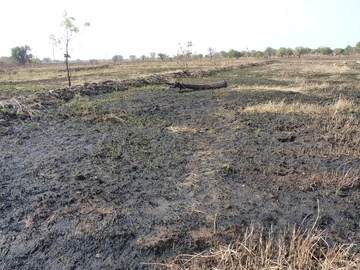Bushfires in northern Ghana: Checks and balances
November 14, 2013.
About 45-60% of the total dry land cover in the northern region of Ghana (representing around a third of the country's total land cover) is burned every year during the dry season between November and February. These annual burns have evolved over the years and become part of local people’s lives. Burns provide goods and services such as land clearance for agriculture, hunting, and pasture for local livestock at relatively low cost. But the burns also lead to losses of plant nutrients and thus pose a serious problem for agriculture, which is characterized by subsistence farming with a low use of fertilizers.
Research objectives and methods
This research aimed at (i) quantifying nutrient losses resulting from the annual fires as well as nutrient acquisition through atmospheric deposition which may compensate for the losses, and (ii) drawing conclusions to support policy-makers in regulating the region's burning culture. The researchers conducted field measurements, applied statistical analyses, and used Geographical Information Systems as well as remote sensing techniques to analyze the relevant processes, their temporal dynamics and the balance of nutrient losses versus gains. They then scaled-up the results for Northern Ghana for a ten-year period (2001-2010).
Negative Phosphorus balance threatens food production
The nutrient balances analyzed confirm the problem with burning: The losses of Nitrogen and Phosphorus - both essential nutrients for plant growth - during the burning phase are much higher than the quantities imported into the entire country in the form of inorganic fertilizers. Furthermore, the losses during burning are not completely compensated by gains through deposition, which means that the nutrient balances are negative. A negative Nitrogen balance is not a major cause for concern, because integration of leguminous crop species in traditional cropping systems supports biological fixation of atmospheric Nitrogen and replenishes Nitrogen stocks in the soil. A negative Phosphorus balance, however, poses a serious challenge to sustainable food production in the region: soils are inherently low in Phosphorus available to plants and most farmers in the region cannot afford to apply synthetic fertilizers containing Phosphorus. Analyses revealed that high moisture in tissues in the early-burn season impedes the spreading of burns. Comparatively low moisture in tissues during the late-burn season make late burns vulnerable to higher losses of Phosphorus.
Early burns could be easy-to-handle solution
It is difficult to impose strict fire prevention mechanisms as the bushfires are a traditional part of land use strategies and culture in the region. A compromise could be a regulation promoting early burns. These findings could be applied to other Savanna regions, which make up around 80% of the global areas burned annually.
Author: <link mail window for sending>Joseph Kugbe
After completing his doctoral thesis at ZEF successfully in October 2012, the author has been working as a lecturer at the University for Development Studies in Tamale, northern Region, Ghana.
The research was funded by BMZ/DAAD.
You can also read the article in <link fileadmin webfiles downloads zefnews zef_news_28_en.pdf download file>ZEF news no. 28 (page 7).



